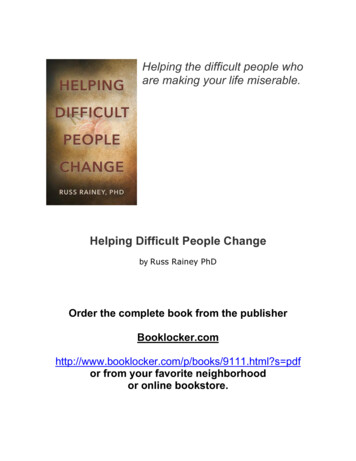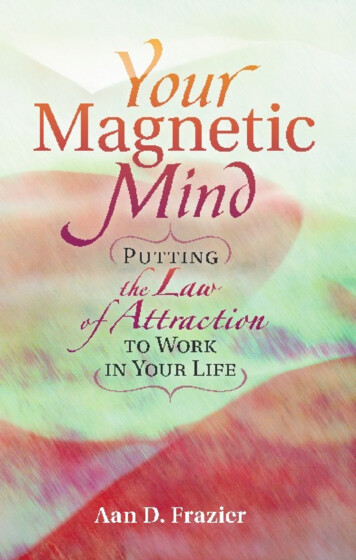
Transcription
Helping the difficult people whoare making your life miserable.Helping Difficult People Changeby Russ Rainey PhDOrder the complete book from the /books/9111.html?s pdfor from your favorite neighborhoodor online bookstore.
Helping Difficult People ChangeRuss Rainey, Ph.D.
Copyright 2017 Russ Rainey, PhDISBN: 978-1-63492-123-7All rights reserved. No part of this publication may bereproduced, stored in a retrieval system, or transmitted inany form or by any means, electronic, mechanical, recordingor otherwise, without the prior written permission of theauthor.Published by BookLocker.com, Inc., Bradenton, Florida.Printed on acid-free paper.BookLocker.com, Inc.2017First EditionScripture quotations are from the ESV Bible (The HolyBible, English Standard Version ), copyright 2001 byCrossway, a publishing ministry of Good News Publishers.Used by permission. All rights reserved.
DISCLAIMERThis book details the author's personal experiences with andopinions about helping others change, but the authorrecognizes that every person and every circumstance isunique, therefore the reader should take this into accountwhen endeavoring to help others.The author and publisher are providing this book and itscontents on an “as is” basis and make no representations orwarranties of any kind with respect to this book or itscontents. The author and publisher disclaim all suchrepresentations and warranties, including for examplewarranties of merchantability and professional advice for aparticular purpose. In addition, the author and publisher donot represent or warrant that the information accessible viathis book is accurate, complete, or current.The statements made about products and services have notbeen evaluated by the U.S. government. Please consult withyour own legal or accounting professional regarding thesuggestions and recommendations made in this book.Except as specifically stated in this book, neither the authoror publisher, nor any authors, contributors, or otherrepresentatives will be liable for damages arising out of or inconnection with the use of this book. This is acomprehensive limitation of liability that applies to alldamages of any kind, including (without limitation)compensatory; direct, indirect or consequential damages;loss of data, income or profit; loss of or damage to propertyand claims of third parties.v
Russ Rainey, Ph.D.You understand that this book is not intended as a substitutefor consultation with a licensed medical, counseling, legal,or accounting professional. Before you begin any change inyour lifestyle in any way, you will consult a licensedprofessional to ensure that you are doing what’s best foryour situation.This book provides content related to options for helpingothers, but that content may or may not be helpful in thecontext of your particular situation due to the complexity ofhuman nature and many factors not mentioned in this book.As such, use of this book implies your acceptance of thisdisclaimer.vi
ContentsIntroduction . 1Chapter 1 – Horse Sense. 9Chapter 2 – Ancient Wisdom . 39Chapter 3 – Coach Approach . 77Chapter 4 - The Change Process . 105Chapter 5 – Modeling Change for Those We AreHelping. 135Chapter 6 – How a Career Criminal Changed HisStripes . 157Appendix A – What is Codependency and How DoYou Overcome It? . 177Appendix B – Overview of Helping a Difficult PersonChange . 191vii
Chapter 1 – Horse Sense“You can lead a horse to water but you can’t make himdrink.”- UnknownHave you ever ridden a rent-a-horse? You know, one ofthose stable horses that people ride while on vacation –the kind of horse that gets ridden routinely by peoplethat don’t have a clue what they’re doing? Please don’ttake offense, but an amateur rider on one of thesehorses is a perfect picture of someone trying to help adifficult person without knowing what they are doing.You see, the horse knows the rider is a greenhorn, andhe has learned all the tricks necessary to make this amiserable experience for the rider. The horse wants toget this over and done with as soon as possible, and heknows that the rider is naïve at best – dangerous atworst, so the horse shows his fear and anger by actingout through resistance or aggressiveness. Does thisremind you of your helping relationship with thatdifficult person you know? When you jerk hard on thereins, the horse, or the difficult person, becomes evenmore stubborn and ornery.Whether it’s intentionally walking under tree limbs orbiting the rider or kicking another horse or just headingback to the barn on a dead run, this horse is going to doonly what he chooses, and there’s not a whole lot therider can do about it. I was once thrown off of a horselike this in the middle of a stream, because the animal9
Russ Rainey, Ph.D.decided that this was a great place to settle an old scorewith another horse from the same stable. Both horsesreared up and began kicking and biting each other, andI was ejected and hit the water upside down. Of course,my horse ran off after he dumped me. After walking acouple of miles back to the stable, I found out that thiswas routine behavior for the horse I was riding, and thestable hand then enlightened me by adding, “Dude,you’re just lucky you landed in the river instead of acactus patch or a pile of rocks.” Thanks for nothing,partner! You knew I was an amateur and this horse wastrouble, and you put me on him anyway.But, there are people who know how to work withhorses like this. In fact, they work with the wildest ofhorses and help them change both their behavior andtheir attitude in a fairly short period of time. One suchexpert is Monte Roberts, and he’s been described as aman who “listens” to horses. Notice that he is not calleda man who “argues” with horses. He doesn’t take themon in a loud, aggressive style. Instead, he might moreaccurately be considered a “horse whisperer”. That is,he has learned to speak the language of horses. Whatsets Roberts apart from old-fashioned horse trainers isthat he doesn’t abuse horses to get them to change theirbehavior – he actually “joins up” with the horse andbecomes partners with it so that it wants to change.Equine change experts like Roberts have the wisdom toknow that a horse described by others as wild, mean, orunbreakable cannot be changed by trying to make them10
Helping Difficult People Changeact differently. Problem horses become hypersensitiveto even being caught, much less controlled. They have astrong fear of a rope being thrown around their neck, abit being forced into their mouth, a saddle beingstrapped onto their back, a stranger sitting on top ofthem, reins being jerked back and forth, and sharp spursdigging into their flesh. Come to think of it, mosthuman beings don’t respond well either to being roped,saddled, jerked around, and spurred. Imagine that!We’ve heard it said that most animals, when faced withdanger or pain, react by fighting or fleeing. Althoughthis is true, it may also be a little simplistic. We shouldalso add two other potential responses: freezing up andfreely joining up. Some animals freeze instead offleeing or fighting. Rabbits, for instance, sometimesfreeze when they see a predator coming. They count ontheir ability to blend in with their natural surroundingsand stay nice and quiet, but their little rabbit hearts arebeating like crazy. Humans may choose this response aswell. Children of abusive parents innately know thatthey have no place to flee, and there is no use infighting. So, they try to disappear – they freeze upemotionally and try to stay out of sight, but their heartsare racing in their chests.Horses are natural fight or flight animals, and theyrarely freeze up. But, like a few other intelligentanimals (and humans), they can opt for an amazingfourth response to distress: freely joining up. Toillustrate this concept using my dog, Riley, this is how11
Russ Rainey, Ph.D.joining up works: Riley, a Border Collie mix, corners alarge possum in our backyard. Everything in him isready for a fight to the finish – he’s aggressivelysquaring off, snarling and barking, and the possum ishissing back with bared teeth. But, when I come over toinvestigate what’s going on, Riley looks at me andwaits for an order. I can say, “Get him!” or I can say,“Back off!” and either way, he joins up with me. If Isay, “Get him”, Riley will viciously terminate thepossum, but he’s likely to get hurt in the process. So, Isay, “Back off” and take care of the possum myself(who has been eating my neighbor’s chickens). Rileywins because he bravely cornered an intruder withoutgetting wounded, plus I give him a lot of praise. It is awin/win situation, except for the poor possum. But thechickens will certainly appreciate his demise.Likewise, with the right human handling, horses canlearn to join up with humans even in very difficultsituations. Bear in mind that horses have played a majorrole in fighting fierce battles throughout history. Theyhave learned to join up with warrior horsemen evenwhen they are required to race headlong into anoncoming army. They remain in partnership with therider even when swords and lances are flashing allaround or a rider is firing a rifle right beside their head.Out of the four alternative reactions mentioned above,there is only one state of mind that is conducive tochange for horses or humans, and that is joining up. Ifwe try to force change, which is perceived as a threat,12
Helping Difficult People Changewe’re most likely to get a fighting, fleeing, or freezingresponse. On the other hand, if we can help another feelat ease, we have something to work with. It may not beapparent, but neither horses nor humans resist change,itself. They may, however, violently resist beingchanged. It seems to be good old horse sense that Godhas not put any one of us in charge of making anotherperson change, but we can offer them an opportunity tojoin up.When trying to help another change, though, MonteRoberts notes, “It is not the great trainer who can causehis horse to perform. The great trainer can cause a horseto want to perform.” (Horse Sense for People, MontyRoberts, 2001, Penguin Putnam Inc., New York, NY,pp. xxii) Roberts has a lot of knowledge and experienceto back up that statement. He studied wild mustangs intheir natural habitat for so many years that he nowunderstands their mannerisms and their fears and cancommunicate in their language. In other words, hespeaks “equine”. As a result, he can tame a wildmustang in less than an hour, which is an incrediblefeat!Most importantly, Robert’s methods are completelyrespectful of the horse he is training. He helps them feelat ease, so joining up is made easier. The horse gets thefreedom to choose to cooperate when it’s good andready. Wouldn’t you love it if you could help a difficultperson become willing to change? Following are someof the lessons that Roberts and other masters of horse13
Russ Rainey, Ph.D.training have discovered over the years. Fortunately,this kind of horse sense can help us avoid the mostcommon mistakes made in working with either horsesor people.Don’t Come Across as a CougarA wild mustang’s most feared enemy in nature is thecougar (also called a mountain lion or panther). Horsesin the wild can sense a cougar’s presence. They knowhis smell and they have studied his stalking behaviorsextensively. They know when the cougar is just scopingthings out and when he is about to spring a ferociousattack. They know if he is simply relaxing in the grassor if he is poised to take the weakest of them out forlunch. So, understandably, the horses are hypersensitiveto being pursued and caught by a cougar.If you and I are as smart as a horse, we will realize thatthe number one rule for helping another change is:don’t come across as a cougar! Does that make sense?Think about it: when a cougar is chasing a horse, whatdoes the horse experience? The cougar is roaring, it hasits teeth and claws bared, and it is in all-out pursuit.Consider that picture for a moment. Have you evergone after another person to help them change but comeoff like a cougar in hot pursuit? I know I have, and itmade things worse. Unlike the cougar, you and I havebenevolent intentions, but how does the other personknow that? After all, they see our behavior, not ourheart. What they experience internally is fight, flight, or14
Helping Difficult People Changefreeze. The adrenaline is pumping, their brain has lostall objectivity, and they are reacting on impulse – notlogic.So, think back for a moment. It’s possible that theperson you’re trying to help has had several badexperiences with you when you were angry, accusatory,manipulative, controlling, and trying to fix them. Whenyour verbal intensity and your body language said “I’mcoming after you”, you were seen as a threat, so theyran, fought, or froze up. Running is expressed inbehaviors like lying, deceiving, disappearing for hoursor days, avoiding you, and ignoring your attempts toconnect with them. Fighting equates to yelling, cursing,becoming violent, stomping off, arguing, and gettingyou off-point by blaming you. The truth is that if wecome across as a threat, it’s natural for the other personto run or fight. And, if we have developed a patternwhere we’re routinely seen as a threat, the other hasceased to respect us or have any desire whatsoever tolisten to what we have to say. It’s like chasing a scaredhorse in a large pasture – not very smart, and we’regoing to get worn out and very frustrated.But, when Monte Roberts works with a horse that isscared, he makes sure that he doesn’t come across as acougar. Instead, his arms are held close to his body andhis fingers are tucked into his hands so nothing remindsthe horse of a cougar reaching out with claws bared. Hespeaks and moves calmly. He wants the animal to knowthat he is not a threat. If we’re going to help others15
Russ Rainey, Ph.D.change, we cannot be perceived as a threat. So, let’s getpersonal for a few minutes:In what way, might your past helping behaviors havebeen perceived as a threat? Make some notes below thatwill help you change your approach in the future.Even more importantly, Roberts does not pursue thehorse. Picture what it would be like to be in a helpingmode but not pursuing the other person. What wouldthat look like? Instead of pursuing, Roberts stands in astationary position in the middle of a corral andencourages the horse to run around the corral in a circleuntil it is tired of fleeing. This helps the horse deal withhis natural anxiety and gives him a chance to see ifRoberts is a threat. Then, when the animal is in acalmer, more receptive state, Roberts actually turns hisback on the horse providing a kind of invitation to comecloser. Horses are naturally curious. So, this is aninvitation to come take a sniff of me and find out whatI’m all about. He is saying to the horse, “See foryourself that I’m not a threat to you. I’m actually16
Helping Difficult People Changefriendly, and I could even have a nice tasty treat in myhand for you.”In a similar fashion, imagine that instead of running ahorse around in circles until it’s tired, you allow adifficult person to talk on and on about his/herproblems until they are tired of talking and somewhatcurious about why you are listening so intently. As thetalking goes on, you just listen and clarify what’s beingsaid and keep asking pertinent questions until theperson simply wears him/herself out. This will almostguaranteed have the effect of non-vocally inviting theperson to join up with you, because you’ve done whatno one else has done – listened non-judgmentally andaccepted them where they are. You’ve proven yourselfto be a friend, not an enemy!Doesn’t it make sense that a calmer, gentler, come-tome approach would work better with those whom youwould like to see changed? The old saying applies here:“You catch more flies with honey than vinegar.” Wecan’t go full tilt at another person with our claws baredand expect them to accept what we have to offer.Working with wild horses or wild people requirespatience and an even temper. If you’ve ever tried tocatch a horse in an open pasture, you know howfrustrated and angry you can get. You pursue and heflees just as you are getting close. It’s as if this horse istrying to make you mad and wear you down so you will17
Russ Rainey, Ph.D.give up. Sounds like that difficult person you know,doesn’t it?Then there is this: when we take the other’s behavior asa personal affront and allow anger to rule our brains, wehave only doubled down on the problem. Not only isthe other defiant, now we’ve complicated the matter byflooding our own brain with negative emotion thatkeeps us from thinking clearly. In this kind of scenario,who really needs the help? When we reach theexasperation point, it’s time to work on ourselves, noton the other. There is truth in the maxim: “Whenyou’ve got a finger pointing at someone else, there arethree pointing back at you.” We are all responsible forour own emotions, and we must control them if we areto help a difficult person change. Often this may meantaking a break and regaining perspective and selfcontrol.Less is MoreWhen it comes to partnering with a horse for aharmonious and enjoyable outcome, the trouble mostinexperienced riders have is that they try to do toomuch. You might say that they over-steer. They jerk thereins around trying to control the horse (to show itwho’s the boss) instead of “letting it have its head”.Those who love to ride horses understand that, undernormal circumstances, riding does not require doingmuch at all. In fact, good horsemen have an“understanding” with their horse, and they realize that18
Helping Difficult People Changethe less they do, and the more the horse takesresponsibility for, the better the outcome. The idea is towork with the horse, not to try to make it do exactlywhat you want. Less is more.This philosophy runs entirely counter to human nature.Our instincts, at least the fallen ones, tell us that if thekey we’ve selected for the lock is not opening the door,we should try it over and over again with more force.We’re driven to try harder, to do more, not less. Ourinstincts tell us that if the nail is not going into thewood, then bang it harder. If the person is not hearingwhat I’m saying, then tell them over and over againwith more intensity and volume. Redouble your efforts.Sadly, this never works. The only person throughoutrecorded history that could truly change another personfrom the inside out with a simple word or a touch nevertook this double-down approach to helping. The personI’m referring to is the Son of God, Jesus Christ, whophysically and mentally healed thousands of people.But, Jesus never tried to make others change. He onlyhealed those who were ready to change. He didn’t chasepeople down to heal them whether they wanted it ornot. Instead, He is recorded as asking even congenitallylame and blind people if they wanted to be healed. Hewanted to know if they were motivated, if they wereready to change. Try to imagine Jesus doggedlypursuing people to heal them (“Hey, get back here. I amtrying to do you a favor, you ungrateful wretch!”). Youwon’t find those kinds of stories in the Bible. I’m19
Russ Rainey, Ph.D.relatively sure that Jesus would have agreed that less ismore.If the less is more philosophy worked for Jesus, theGreat Healer, it should work for us as well. We cannothelp difficult people if we over-steer and try to controlthem. Remember: our tendency when trying to helpanother change is to do more than we should. Someexamples of doing too much for another might include: Offering more advice and control than theywant.Over-rewarding good behavior.Over-punishing bad behavior.Doing things for others they are responsible fordoing themselves.Caring more for others than they care forthemselves.Providing more for others than they provide forthemselves.Rescuing others repeatedly instead of allowingnatural or logical consequences.In counseling terms, giving too much unwanted help iscalled “enabling”. Enabling never creates positivechange in another. It actually rewards the other’s badbehavior and self-centered thinking. It’s like continuingto hand-feed a hungry horse that bites your hand everytime you feed it. But like the person with the sore hand,we’re slow to learn. In counseling sessions, I’ve noticed20
Helping Difficult People Changethat when a client is confronted with the observationthat they may be enabling another’s bad behavior, theyimmediately deny this fact and say something like, “I’mnot enabling! I’m just trying to get him to see that gether to be more get him to stop his get her tounderstand that get him to avoid ” This is classicover-steering vocabulary. And, over-steering isenabling.Here’s the hard truth: guess who actually benefits mostfrom all this over-steering and enabling? The enabler,the one who is trying their best to control the personand the situation for their own relief and benefit! Justlike a horse resents over-steering and tries to regaincontrol of its head and its direction, a difficult personresents fixing and rescuing and tries to escape thehelper’s control. A rider often feels he must control hishorse (because the rider is scared and insecure), so hekicks it in the flanks and jerks the reins back and forthaggressively. An enabler feels scared and insecure andtries every strategy conceivable (from being extra-sweetto being ultra-controlling) to see what works best. Boththe unwise rider and the unwise enabler may believethat they are doing what’s necessary to help, but bothare at least somewhat blind to their own motivation,which is, to create better feelings and a better outcomefor themselves.When this happens, there is no workable partnership.One party in this situation is going to buck up and theother party is going to get bucked off. Remember: less21
Russ Rainey, Ph.D.is more, and the more compulsive we feel abouthelping, the more we should back off. Compulsivehelping, the kind of helping that is not asked for orappreciated, is also called “codependency”. Please seeAppendix A to learn more about this important topic.Joining Up vs. Blowing UpHorse-trainers in the old days wanted the wild horse toknow who was in charge, and when a horse didn’tcooperate, the trainer often got angry and took it out onthe horse. The controlling methods that horse handlerschose were often cruel and abusive. Horses could betied to a post, forcibly pulled to the ground, beaten, orworse. They were only considered “broken” when theywere almost completely bereft of any spirit orpersonality.Unfortunately, some of those methods are still practicedtoday by uninformed horse trainers. But, Monte Robertsdeveloped methods that do not require controlling orabusing the horse. Instead, these approaches allow himto speak the horse’s language and form a mutuallybeneficial partnership with it. Through thousands ofhours of observation, Roberts discovered that horseherds in the wild use two general methods of gainingcompliance and producing change in a herd member.They use a “sending away” tactic within family groupsas discipline for an unruly horse. Then, they use a“joining up” process to re-create trust and the changed22
Helping Difficult People Changebehavior that benefits both the unruly horse and theherd.Imagine a horse that is creating trouble for the rest ofthe herd. This horse is going against the social normsthat govern herd behavior – rules that keep the horsessafe and working as a team. Instead of being a teamplayer, though, the difficult horse is doing whatever itfeels like doing and has become an annoyance and adanger to the other horses. This horse may go ahead ofthe herd or lag behind it. It may kick and bite the otherhorses and even create a stampede from time to time.The difficult horse requires the herd to focus on him/herinstead of focusing on the herd’s safety, sustenance, andherd relationships. From the herd’s point of view, it’stime for a change.Using the “sending away” tactic, the lead mare of thefamily group will run the difficult horse out of andaway from the rest of the herd. The herd leader thusensures that the difficult horse has no herd interactionuntil improved attitude and behavior are observed.When the troubled horse once again submits toauthority, there can be a “joining up” process whichsignals a second chance to form trust and become afunctioning member of the herd. So, instead of the leadmare trying to fix and control every move of thedifficult horse while it’s in the herd, she simply sends itaway for a time to enhance the natural desire to beaccepted, and this keeps the herd safe as well. Sounds alittle like the “time out” method we use with children,23
Russ Rainey, Ph.D.right? Instead of trying to make a difficult personchange, have you ever thought of simply sending themaway for a while? Not to Abu Dhabi, just out of yourphysical presence or away from your emotionalwarmth. It’s a natural consequence for upsetting thefamily system.In Monte Robert’s approach, he mimics the lead mare’sform of discipline. He operates inside a corral and sendsthe difficult horse away by first confronting the horsethrough an eye-to-eye, assertive position resemblingwhat would happen in a herd with the lead mare staringdown a difficult herd member. Remember the look yourmother or father could give you when you were beingan unruly child? This look establishes Robert’sauthority in the relationship. The difficult horsenaturally begins moving away, and Roberts throws aloose rope behind the animal to start it running aroundthe corral.The troubled horse eventually tires of circling thecorral, dislikes the fact that it has been sent away, andbecomes somewhat submissive. Horses, like humans,are relationship-driven. They need to join up. So, thedifficult horse indicates its submission by lowering itshead and actually turning an inside ear toward thetrainer showing that it is ready to listen – open tonegotiation. At that point, Roberts ensures through hisown gentle but firm behavior that the horse knows thetrainer is both safe and in charge.24
Helping Difficult People ChangeAnd then he does something paradoxical. He turns hisback on the horse and waits for it to come to him. Ofcourse, Roberts has a reward in his hand that certainlyhelps the horse consider exploring a new option. Butthe horse understands this arrangement due to his herdinstincts, and he soon begins the join up process withthe trainer. Before long, the horse is nuzzling Roberts inthe back with its soft nose as a gesture of trust. Are yougetting the picture? We can’t have a join up unless wefirst have a sending away.Imagine yourself assertively sending away that difficultperson in your life. This may or may not requireliterally sending him/her out of your house, dependingon the age and the life circumstances of all involved,but even sending them out of your physical presence fora time or away from your emotional connection can beeffective. Then, when the person desires a relationshipagain and appears remorseful, imagine joining up withthem in a way that requires that they come to youwilling to create a new social contract. If they refusethis offer, the same sending away process can begin allover again. Use the space below to envision how youmight use the process described above to begin a newand improved relationship with your difficult person.25
Russ Rainey, Ph.D.I wish I had a nickel for every time I have suggested toenabling family members that they simply send afamily member away when there is serious misbehaviorand the using of others for selfish agendas. Instead,many family members do the exact opposite – theycontinue an enmeshed pattern of over-steering andtrying to make the troubled person do what they “oughtto do”. These efforts are doomed to failure, but it’samazing how many times people will repeat the sameineffective pattern over and over again. We can learnsomething powerful, though, from a horse whispererwho knows the transformational results of sendingaway and later joining up.To be clear, sending away is not the same thing asemotional rejection or punishment. It doesn’t conveyanger or hatred or disgust. It simply and calmly conveysthe message that, “We love you, but we won’t toleratethe damage you are doing to yourself and others, so,you must go away until you have reconsidered anddecided to act differently.” Remember the story of theprodigal son in the New Testament? The biblical fatherin Luke 15:11-32 gives us a real-life example ofsending away and joining up. It looks like the old truthis still the best truth.26
Helping Difficult People ChangePlease note this caveat, though: there are times in a fewdifficult persons’ lives when sending away is notappropriate. When a person’s thinking or behavior is aserious threat to themselves or others, a medical and/orlegal intervention is in order. For these extremecircumstances, extreme measures are required. The caregiver may need to call 911, see a judge aboutcommitment procedures, and do everything possible toensure that the difficult person and others are not beingharmed. In the midst of these unpleasant actions, thecare giver will often be seen as “the enemy” of thedifficult person, but the interventions must be followedthrough with regardless.Joining up, then, is recreating a safe, trustin
Helping the difficult people who are making your life miserable. Helping Difficult People Change by Russ Rainey PhD Order the complete book from the publisher . fighting. So, they try to disappear - they freeze up emotionally and try to stay out of sight, but their hearts are racing in their chests. Horses are natural fight or flight .


![Change Management Process For [Project Name] - West Virginia](/img/32/change-20management-20process-2003-2022-202012.jpg)







